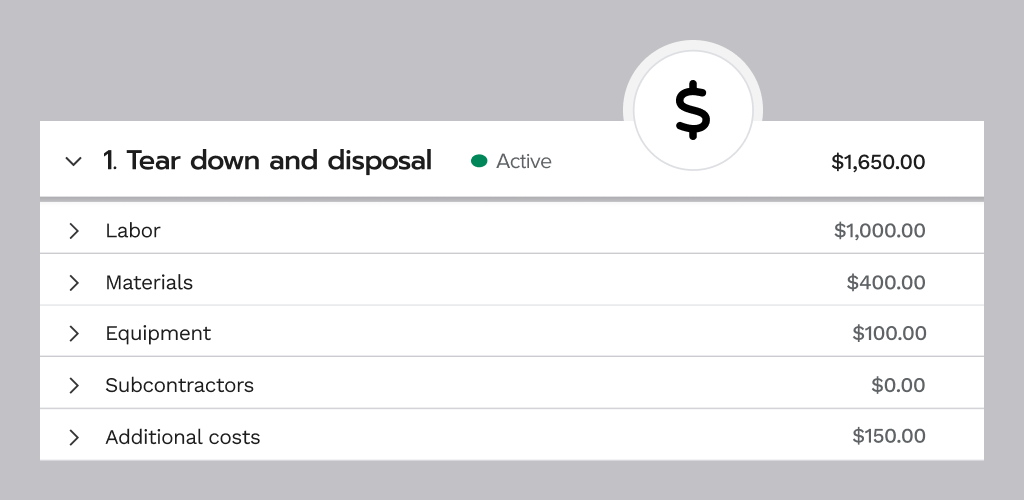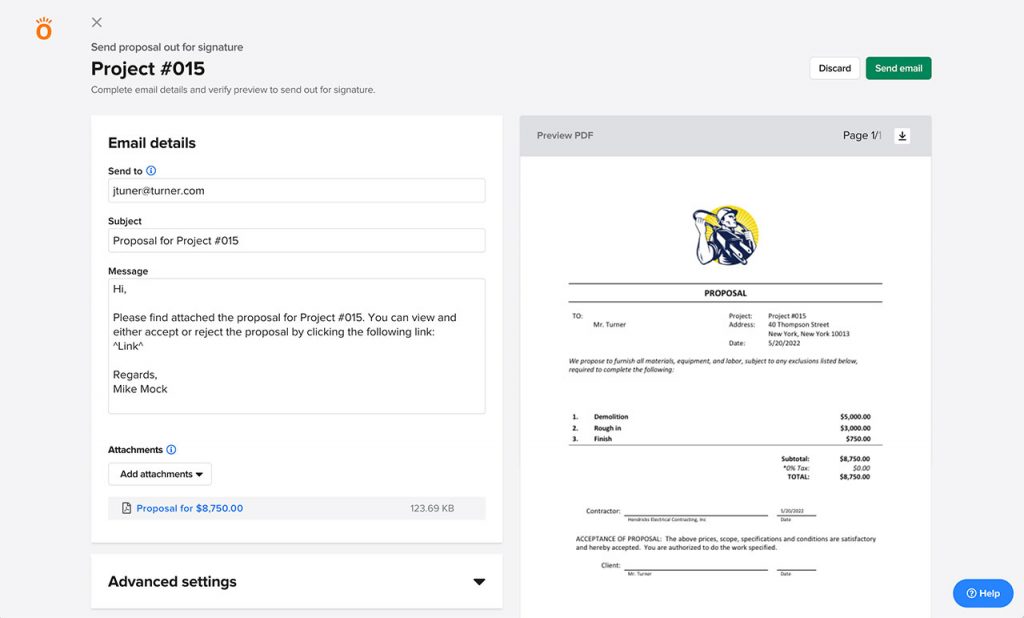Are you confident in your pricing strategy? Do you never second guess whether you’ve left money on the table after a job? How do you know that you’re getting honest pay for honest work? If you struggle to answer these questions, don’t worry, you’re not alone, which is why we’ve put together this comprehensive contractor pricing guide.
Pricing is far more than just attaching a dollar amount to a service. How a business approaches pricing holds a surprising amount of information; it signals perceived value, influences customer behavior, and establishes marketplace presence. On a job-by-job basis, pricing can be used to improve profitability and create a long-term competitive advantage for achieving financial success.
For these reasons, the moment contractors ignore pricing is the moment they put their reputation and profits up for grabs. Achieving profitability and hitting financial goals is not a matter of luck; it is a matter of knowing your numbers and executing jobs with precision through effective pricing.
This contractor pricing guide will outline four of the most common pricing methods used in construction contracts, key considerations for pricing jobs, and best practices designed to help contractors make informed decisions ensuring they are accurately priced and competitively positioned.
Need help organizing and tracking jobs? | Save hours of your time with Knowify
Build project budgets and proposals, track costs, and so much more with construction-specific features that respect your time. Read more
Construction pricing models
Fixed price contracts
Fixed price contracts establish a fixed sum of money that encapsulates the entire project. With this pricing model, contractors will quote a single price to perform the entire project. Fixed price contracts are best for clearly defined scopes of work. This allows contractors to accurately estimate total costs before submitting a quote that will cover job costs and generate a profit.
However, this price is set in stone; even if job costs far exceed what was expected, the contractor must bill the original amount agreed upon. A big caveat here is change orders, of course; change orders, however, will still work under the confines of a fixed price and will provide a new quote for work to be performed under a new set price.
As mentioned, fixed-price contracts are best suited for scopes of work that allow contractors to anticipate timelines along with labor, material, and equipment costs with a high degree of accuracy. Contractors may favor this pricing model because these contracts are easy to craft, execute, and track.
They also leave plenty of room for contractors to plan scheduling, material purchases, and efficiency to ensure a profit is made. Only the contractor’s profits will be affected if actual costs are higher than estimated.
However, if the contractor can manage costs effectively, profits will increase. Either way, the owner will pay the same price. Ultimately these contracts provide a transparent, simplified foundation for project execution.
Unit price contracts
Unit pricing, or “measure and pay” pricing, works by dividing work items or materials into separate “units,” with each unit holding a cost. For example, a contractor can break down total labor costs into a price per square foot; with the price per square foot serving as the “unit”. Unit pricing will ask contractors to calculate specific unit costs, such as the cost per hour to build a 100-foot fence; or the cost for your team to pour a cubic foot of concrete.
Unit pricing works best with an undefined scope of work. Contractors provide their best gauge on the cost of completing a unit. As the project grows in scale–for instance, building 100 feet of fence turns into building 200 feet of fence–contractors can bill additional units as needed.
This is the main differentiator of unit pricing compared to fixed-price contracts. Contractors are entitled to compensation based on the actual quantities of work performed. For this reason, contractors must pay close attention to the markup percentages they apply to unit pricing contracts. As more work is performed, contractors must apply an appropriate percentage to cover total project cost while generating a reasonable profit.
Cost plus contracts
Cost-plus pricing is a method in which contractors are paid for all expenses plus a separate percentage or set fee to cover profit. Owners will pay for the actual cost of materials, labor, equipment, and additional job costs, plus a negotiated fee that typically comes as a set percentage. Cost-plus contracts place most of the risk on owners and are favored by contractors since profit is baked into the contract.
Cost plus pricing is often used when it’s difficult to determine a project’s final scope and cost upfront. It provides added flexibility as adjustments can be easily made. However, there is a duty on the contractor to provide a detailed itemized list of every expense incurred on the project.
Meaning contractors must be prepared to justify any and all expenses since the owner will need to front more cash. This requires contractors to keep detailed records and documentation throughout the entire project.
Time and materials (T & M) contracts
Time and materials (T&M) pricing has contractors provide an hourly rate for labor followed by an estimate of how long the project will likely take, resulting in a rough price range. Material costs will be passed directly to the project owner, while labor will likely be charged hourly.
Some contractors may choose to apply a markup percentage on top of material costs. If choosing to do so, a typical markup percentage will fall between 10%-30%, although the exact rate will need to be negotiated with the project owner. With that said, contractors should plan for most of their profit generated through invoicing for labor hours.
This type of contract is used if the scope of work or timelines are undefined or if material prices are expected to fluctuate. T&M pricing provides reduced risk for contractors, along with invoicing that can be done quickly, but there are drawbacks, such as a reduced incentive for efficiency and the need to front job costs. This type of pricing is often used when the scope of work is not well defined or when the project is expected to have many changes.
No matter which pricing model you prefer, Knowify has you covered - see how you can build budget-backed bids in minutes
What to consider when pricing
Project type & size
As we have seen, the contract type will significantly impact how contractors price their services. A fixed-price contract will need to be handled differently than a cost-plus contract, as each will depend on the scope of work, timelines, project requirements, site conditions, and direct project costs fronted by the contractor.
Routine jobs in which you can accurately estimate costs can be priced far easier than complex jobs that require specialized materials or equipment. When it comes to the latter, more time will be spent on developing a pricing strategy that will generate a sufficient profit for the job.
If you need help to price a specific job, look back to see if any similar jobs have been tackled in the past. Determine if any unforeseen costs were incurred that were not initially planned for.
For example, perhaps this job required additional materials, or a portion of the job had to be subbed out. Use this information to adjust your markup or budget accordingly to give more room for profitability for the upcoming job.
Pricing can also be affected by whether a job falls into the private or public sector. Commercial jobs will come with different contract terms from government jobs. Ensure you are triple-checking the scope of work and project details so you know what confines you are working under.
Location
Location will impact pricing in several different ways. One being local economies and market conditions. Cost factors like labor, materials, transportation, the standard of living, and the availability of skilled workers will play a significant role in how a contractor will price jobs. High-cost areas will bring higher levels of insurance, taxes, material costs, and labor rates.
Contractors will need to factor this in when pricing their jobs to ensure they are staying competitive while at the same time remaining affordable to attract business. In some cases, the contractor may need to charge a premium for the job to cover the extra costs associated with the location.
The physical location of the job will come into play as well. Site conditions that present unique or challenging obstacles should always be factored into job costs. Always inspect the site before signing contracts. Additionally, if the job site is in a remote location requiring a long commute, this will need to be factored into labor costs, which will affect the overall price.
Expenses
Every successful pricing strategy will start with determining how much it costs you to perform the job. Contractors should calculate all significant job costs for the given project. This is best done by breaking the job into phases or stages with cost estimates for each phase.

It’s crucial to have a granular understanding of every cost that will be incurred on a job. It’s the only way to arrive at a healthy profit margin. Profit is not a mysterious outcome that takes luck. It can and should be calculated for every job.
This starts with knowing your cost numbers. Every construction business owner must charge enough to cover job costs, pay employees, pay overhead expenses, and make a reasonable profit to keep the business running.
Taking the time to evaluate job costs with a fine-toothed comb will reveal the information needed to properly apply markup, schedule crews, purchase materials, and execute jobs profitably. Once costs are determined, contractors can use a margin & markup table to find an appropriate markup multiplier to apply an effective percentage to cover profits. The national construction industry average for markup falls between 1.54 – 1.67, but contractors should use a number that is right for their business needs.
Financial goals
Setting financial goals is paramount for any business owner to not only make business operations profitable but to ensure you have enough cash coming in to support you and your family.
Pricing should always be done in conjunction with financial goals. Goals could be hitting a desired salary amount, growing sales by a certain percentage, hitting a profit margin of a certain percentage, or growing revenue in order to hire new employees.
Whatever the goal, pricing will be a major tool for achieving those goals. Nothing should be arbitrarily done. Prices should not be raised or lowered based on feeling alone. Prices should be set intentionally, with a financial goal at the other end that can be used to measure the success of the pricing strategy.
Contractor pricing best practices
Set financial goals
Setting financial goals is the most important thing contractors can do to improve their pricing strategy. As we have mentioned, pricing should be done intentionally; starting with a plan is the only way to ensure your pricing is working towards a clear end in sight.
Don’t set a price based on intuition. Even with decades of experience, contractors should use financial goals to ensure they are getting the most out of their pricing.
Determining these goals will depend significantly on the individual contracting business’s trade, location, and personality. This will require a lot of self-reflection. What is most important to the business? What is the biggest strength?
What is the biggest weakness? Do we want to expand? While these are great starting points, contractors should work to break down these larger questions to arrive at actionable business goals. These actionable goals may include increasing profit margins, increasing sales volumes, improving efficiency, or expanding services.
If contractors are still unsure where to start, focus on your salary as a business owner. Aim to take home at least 8% of all sales volume as payment. For instance, a personal salary goal of $60,000 would require a sales volume of $750,000 to support that desired salary. “Improving overall sales volume” can now be used as a financial goal, with pricing used as a fundamental tool to achieve that goal.
Understand the scope of work
Pricing effectively starts with understanding the scope of work. A scope of work will detail crucial pieces of information, such as objectives, deliverables, schedules, and requirements. These details should be used to form accurate job cost estimates that can be used to price the job.
Evaluating the scope of work gives a valuable opportunity to talk to the project owner to discuss the location, evaluate site conditions, and hammer out additional details that will affect costs.
Any misunderstanding in expectations or project details can result in severe cost overruns. These details, such as specialized materials or specific building techniques, must be understood for contractors to price each project phase effectively.
If, at any time, contractors need help when trying to lock in a price, they should always refer back to the scope of work to get the information they need to move forward.
Negotiate
Contractors should never assume that their hands are tied when it comes to negotiating. Project details may require contractors to increase prices to cover costs or purchase specialized materials. If this is the case, contractors should feel confident discussing prices, terms, and expectations with the project owner.
It’s vital to open up communication during the early phases of a job to ensure these kinds of problems can be solved before they result in cash flow issues or job delays. In order to be successful when negotiating, you must know your numbers inside and out.
Always back up claims or changes with accurate numbers. If you can speak confidently about your side of the project, you are more likely to come to an agreement that can work for you and the project owner.
Track expenses
Tracking expenses on a consistent basis is vital for evaluating the effectiveness of a pricing strategy. Creating a historical database of job performance can be used to ensure bids are based on actual cost amounts. Job costs directly influence profitability; tracking costs means that contractors can identify if they are losing money or underpricing jobs.
Contractors should always avoid assumptions, as no two jobs are identical. Even when it comes to a routine job, reviewing past performance will reveal where efficiency or cost improvements could have been made. Identifying improvements enables contractors to accurately price jobs to stay competitive and profitable.
Tracking expenses is made more accessible by utilizing construction management software. These tools immediately process and categorize job costs so contractors can identify how much was spent on material and labor costs, equipment, and subcontractor fees.
Better yet, the right software can turn data into actionable reports to better understand job performance. The greatest advantage of digital tools is accuracy and speed. Staying up to date with job costs, project details, and customer needs allows contractors to immediately gauge costs and submit competitive bids for every job.
Accurately send price quotes using Knowify

Knowify empowers contractors to accurately send price quotes through the ability to create and manage customizable quotes and templates.
Contractors who use Knowify can expect to easily organize pricing information, track job costs, and generate professional quotes in just minutes; quickly add and subtract items on a quote to clearly lay out work to be performed with exclusions and contract terms. Better yet, this is all done using professionally branded documents to foster better communication with clients.
Through Knowify’s streamlined quoting process, contractors are able to access all the contact information, with a complete catalog system with prices and previous quotes.
From there, our built client portal will give clients access to accept, reject, request changes, and sign electronically. Provide estimates that are tailored to your customers’ needs with Knowify’s quoting capabilities.
Maximize profits and minimize job costs with Knowify
Take control of your budget and streamline your construction projects with Knowify’s powerful construction project management software.
